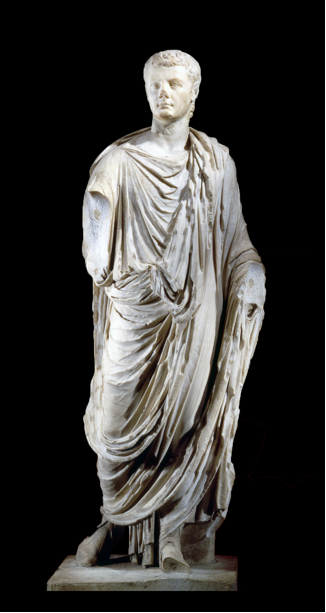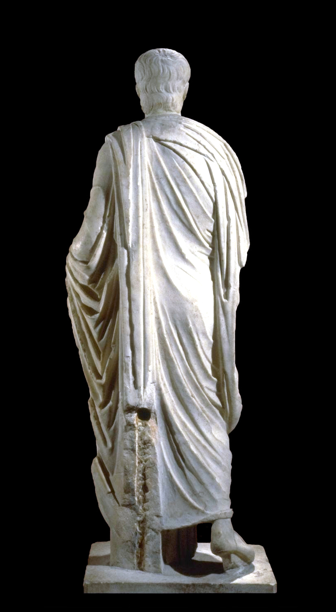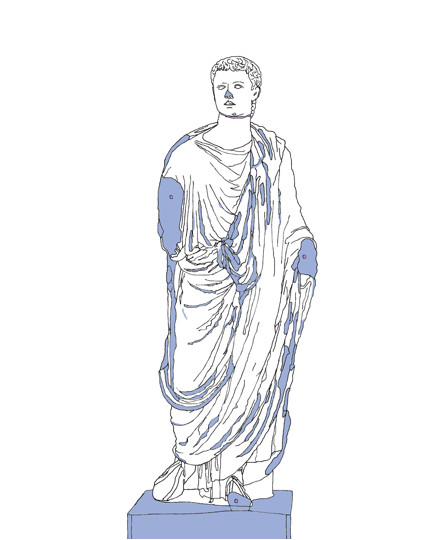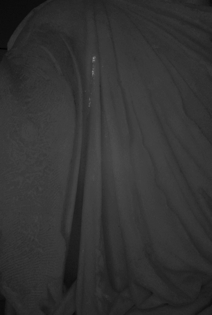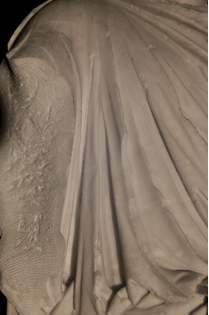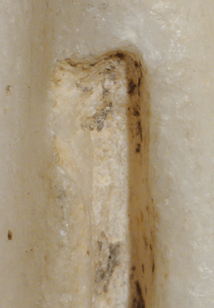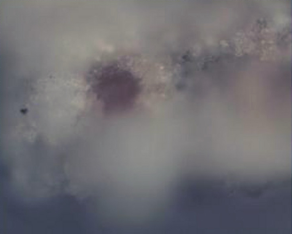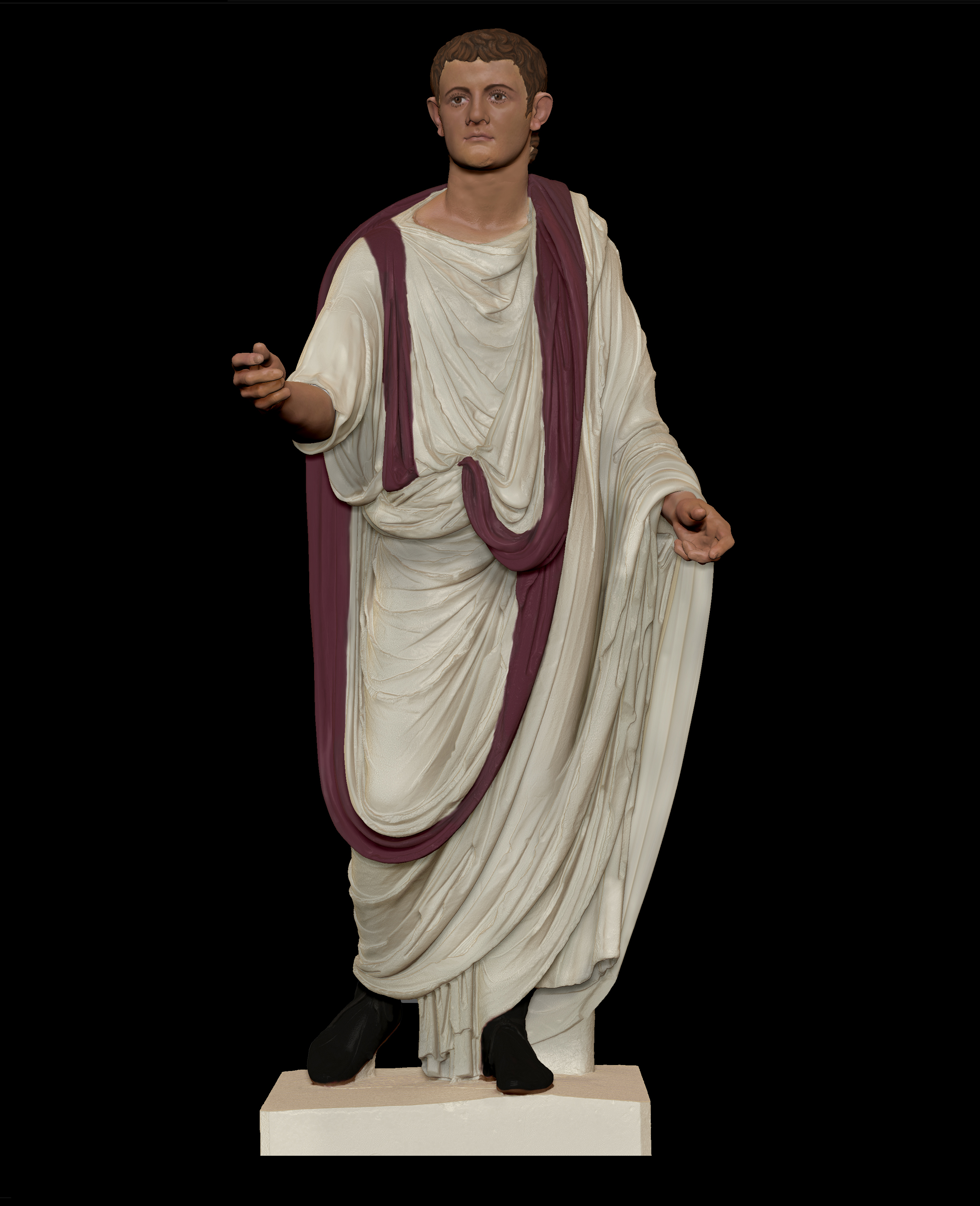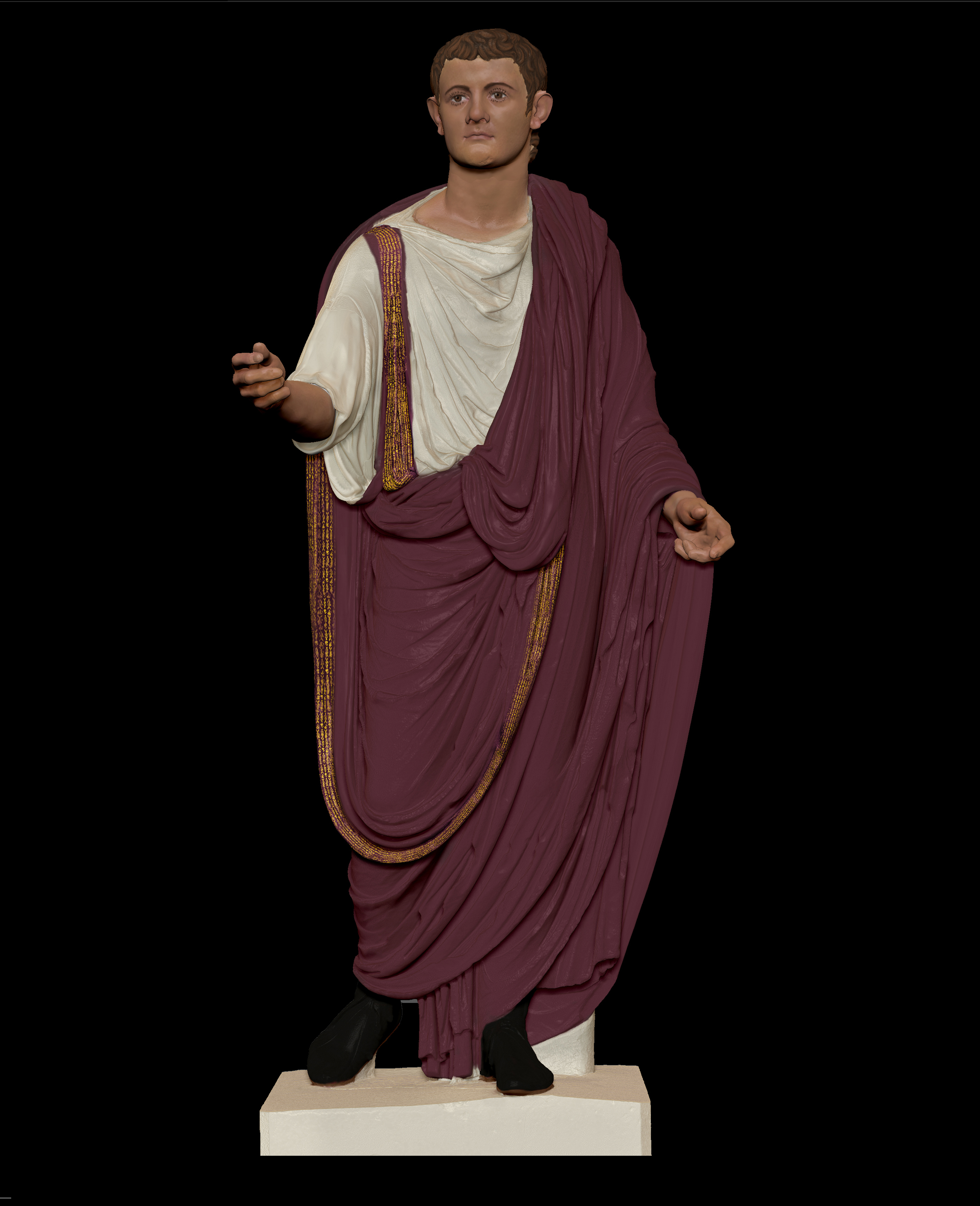The Togatus Statue of Caligula in the Virginia Museum of Fine Arts: An Archaeological Description[1] |
Mark Abbe |
The over life-size togatus statue of Caligula (Gaius Julius Caesar Germanicus, the infamous third emperor of the Julio-Claudian dynasty, ruled A.D. 37-41) in the Virginia Museum of Fine Arts is both a masterpiece of art and an artwork of exceptional historical importance (figs 1-2).
To date, however, this statue has received only summary accounts of its physical condition. This paper aims to fill this outstanding lacuna by providing a detailed archaeological description of this remarkable statue. The aim is threefold: (1) to identify and distinguish the statue's virtuoso "metropolitan" ancient marble carving from its extensive, but heretofore largely unexamined, nineteenth-century restoration; (2) to present new information regarding the statue's limited extant remains of ancient polychromy; and, finally, (3) to understand the sculpture's exceptionally well preserved condition in historical terms, namely, as evidence for its display and statue life in antiquity.[2]
Collection. Richmond, Virginia Museum of Fine Arts, Inv. 71.20
Material.The ancient statue is carved from a highly-crystalline medium to small-grained white marble, with no visible flaws and faint vertically-oriented bedding planes.[3] The marble has not been properly scientifically characterized and its geological provenance remains undetermined. It appears likely to be either a high quality imported Greek marble or, possibly, a top quality Luna marble.[4]
Dimensions. Overall, in present condition: H. 203.0, W. 67.3, D. 49.5 cm.
Provenience. Found in 1825 at Bovillae, Italy in excavations sponsored by Vincenzo Colonna, the statue was previously erroneously reported to have been found near the Theater of Marcellus, Rome.[5] Maria Grazia Picozzi has discovered archival documentation suggesting that the core of the statue was found with fragments of the arms, the front of the left foot, and bits of drapery, and that the head was discovered in close proximity.[6]
Provenance and Post-Antique Interventions. After its discovery, the statue was restored to form a complete, legible figural sculpture according to contemporary aesthetic standards and was subsequently displayed in the Palazzo Colonna where its restorations and location were recorded by F. K. von Duhn in 1878/9.[7] In 1968 the sculpture was offered on the antiquities market in Zurich by J. Brun (with H. Jucker advising) from whom it was purchased by the Virginia Museum of Fine Arts (VMFA) in 1971. The statue was promptly restored for exhibition by the prominent art restorer J. Ternbach in New York, and entered the museum's collection in the spring of that same year (Object files, Virginia Museum of Fine Arts and Estate of J. Ternbach).
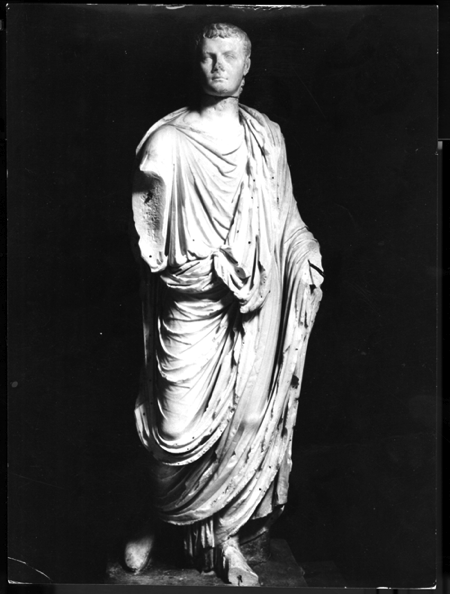
|
| Fig. 3.Photograph of the statue of Caligula first provided by J. Brun to H. Jucker in 1968, and subsequently to VMFA and J. Ternbach in 1970/71. Photograph: Estate of J. Ternbach. |
The earliest known photographs of the statue were provided by J. Brun to H. Jucker in 1968 (fig. 3) and appear to have been made immediately after the now-missing historic restorations noted by von Duhn had been largely removed, but the iron pins used in the historic restoration in the arms and left foot remained. This de-restoration was undoubtedly aimed to demonstrate the authenticity of the ancient core of the statue according to the purist taste common in northern Europe in the late 1960's and 1970's.[8] After the statue was purchased by the VMFA, J. Ternbach remounted the head in what he considered to be its correct ancient position and then filled in the empty pin and dowel holes created by the historic restoration to create a more pleasing display appearance. Apart from the removal of the fill around the break in the neck and limited subsequent surface cleaning, the statue remains essentially in this condition.
In response to long-standing doubts about whether the head belongs to the statue, M. Mayo, Ancient Curator of the VMFA, undertook a detailed reexamination of the statue in 1988-9. Radiography of the neck join revealed a very deep dowel hole and the apparent absence of a true marble-to-marble locking join surface suggested by J. Ternbach. Preliminary stable isotopic analysis suggested that the head and body were composed of a similar type of white marble.[9] A preliminary attempt to remove the head in order to examine the join and correct its position was initiated but was aborted due to the reinstallation schedule of the ancient galleries.[10]
While the physical history of the statue since 1968 is well documented, the historic restoration of the statue has received almost no mention in the modern descriptions of the statue since von Duhn. The uniform technique of the marble cuttings, surface preparation, and joining technique for the now-removed marble repairs indicate a single, extensive restoration campaign. This must have been carried out between the statue's discovery in 1825 and von Duhn's 1878/9 inventory of the Colonna Collection. This historic restoration can now be dated conclusively by a heretofore unnoted horizontal inscription (letter H. 2.5 cm) reading "1843" on the reworked restoration join surface of the left arm (figs. 4-7).[11]
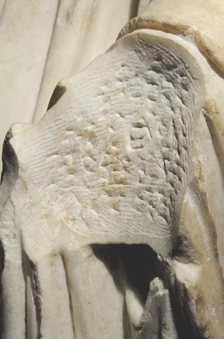
|
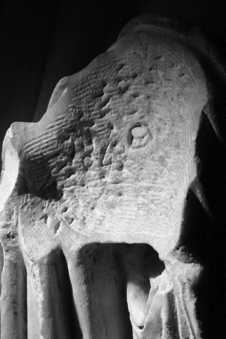 |

|
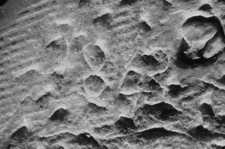
|
| Fig. 4-7 Inscription reading "1843" on the reworked restoration join surface of the left arm. Ambient and raking light. Photographs: M. Abbe. |
This deliberate and carefully-carved inscription was not visible once the statue was restored. Coincidentally with the recent discovery of this inscription, M. Grazia Picozzi has now identified archival evidence in the Colonna Archives recording the payment in 1843 to the sculptor Raffaele Tuccimei (1812-1849), a student of Canova, for the restoration of a statue of a "Console" from the Colonna excavations at Bovillae (See Picozzi). This fortunate corroboration of the inscription and archival evidence (1) confirms the reading of this inscription, (2) demonstrates that the inscription records the date of the restoration work, rather than a workshop inventory number or the like, and (3) leaves little doubt about the sculptor involved.
Von Duhn's 1878/9 description of the statue refers to it as a complete figure with arms, and the overall impression was probably akin to the other freestanding restored ancient sculptures in the collection.[12] Detailed examination now has revealed the full extent of the nineteenth-century restorations (fig. 8).
The exposed deep cuttings into the ancient core of the statue may shock the modern eye, but in truth reflect a controlled, deliberate, and skillful restoration technique of precisely-cut marble-to-marble joining. This masterful, technically refined joining extended to even the smallest folds of drapery and created a complete, unified, and, thus, legible statue. All of these careful historic repairs to the statue have been removed, save the post-antique plinth required to secure the statue.[13] The historic restorations extend only across the front and sides of the statue and do not extend to the large damaged areas on its back. This indicates that the restored sculpture was intended for display against a wall or in a niche.[14]
Condition. The statue is currently composed of three assembled pieces: (1) the ancient head (H. 30.0, W. 20.5, D. 22.5 cm), which broke (or was broken) off of the body of the statue at the upper neck in antiquity and has been reattached, (2) the central core of the ancient statue (H. preserved figure 188.7) preserving the body from the upper neck to the base of the feet including the ancient plinth between the legs of the figure, and (3) a tall, wide modern plinth (H. 16.5, W. 67.5, D. 49.5 cm) into which the reduced ancient plinth was set (ancient plinth: W. 51.5, D. 37.5 cm) to support the statue in the historic restoration.
The repairs executed in the historic restoration display a careful and technically masterful application of historic marble joining technique. This involved the excising of areas of loss and break edges and joining precisely-fitted marble repairs, often of extreme complexity. The prepared join surfaces on the statue have a smooth, flat-chiseled perimeter for the join edge and a "keyed" anathyrosis interior prepared with a distinctive flat tooth-chisel and deeper gouges made with a point. Large holes in the center portions of the prepared surfaces housed iron dowels and numerous smaller pins structurally supported smaller marble attachments. Once assembled, any remaining gaps between the assembled marble-to-marble joins were no doubt filled with plaster.
Large restorations to the statue were made: (1) between the upper neck and lower head, (2) at the left forearm (H. 16.5, W. 13.5, D. 4.0, Dia. of dowel hole 1.5 cm), (3) at the right forearm (H. 42.3, W. 13.5, D. 8.0, Dia. of dowel hole 3.5, D. of dowel hole 1.8 cm), and (3) at the forepart of the left foot (H. 6.0, W. 10.0, Dia. of dowel hole 1.0 cm). Preparations for numerous smaller marble repairs are evident across the front and sides of the statue: the tip of the nose, the upper reverse and lower portion of the left ear, the lower portions of folds of the tunic over the lower right chest, and extensive areas of the drapery ridges and folds of the toga. The marble repairs to the toga are concentrated on: the upper horizontal folds of the balteus, the lower right and forward sections of the umbo, the vertical falling portion of the sinus along the figure's right flank, the forward sections of the sinus below the figure's knee, and the edges of the ima toga from between the legs to its vertical fall along the figure's left side. The overwhelming majority of these small marble restorations were attached by small pins inserted into drilled holes of a standard (0.5 cm) diameter. Smaller repairs, such as on the tip of nose, required a significantly smaller (0.2 cm diameter) pin hole. All of the larger dowel and smaller pin holes have now been filled with plaster to unify cosmetically the piece for museum display.
The cuttings made in preparation for the historic restoration have largely obscured the original archaeological damage across the front and sides of the statue. Only minor areas of loss remain in their original condition, such as the chip in the chin, larger chips in the middle neck, and minute folds of drapery. These appear to have been simply patched and filled with plaster in the restoration. Vestiges of this plaster remain on the front of the toga.
The ancient break surfaces on the upper neck and lower head were reworked in the historic restoration and do not appear to preserve an ancient join.[15] The outer edges have been extensively recut with a flat chisel and have significant areas of loss (figs. 9-11).[16]

|
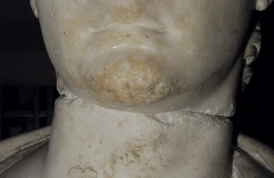
|
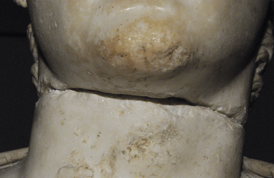
|
| Figs. 9-11 Details of break at upper neck and lower head from front: head overall, horizontal view, and view from below. Photographs: M. Abbe |
The interior join surfaces appear to have been "keyed" with a flat chisel and point. The current position of the head, as restored in 1971, is misaligned and erroneous: the head sits too low, too far forward, and multiple areas of the join are not precisely coordinated all around (figs. 12-14).
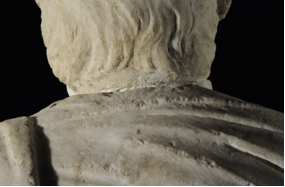 |
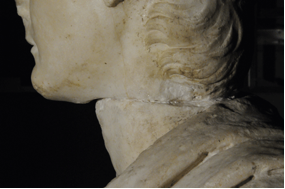 |
 |
| Fig. 12-14. Details of break at upper neck and lower head from the reverse, and the left and right sides. Photographs: M. Abbe. |
The head appears to be turned slightly more to the proper right than in the original and incorrectly inclined forward. There is extensive modern fill material in the reverse neck join while the front of the neck rests marble-to-marble. This appears to be visible in the radiographs of the join (figs. 15-16).[17]
 |
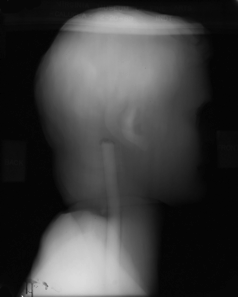 |
| Figs. 15-16 Radiographs from 1989 examination illustrating the existing restoration of the join at the upper neck and head with steel pin, dowel cutting, and current marble-to-marble join. Radiographs: VMFA, kindly provided by Kathy Gillis. |
The unrestored reverse of the statue has small ancient losses, preferentially on the raised portions of the drapery, and a concentration of damage in the lower vertically-hanging sinus. Two external iron elements in this area anchored the statue to external supports. (1) An external iron element was inserted and fixed with molten lead in the large, deep rectangular dowel hole (H. 5.0, W. 4.5 D. 13.2 cm) to anchor the statue horizontally against an external vertical support, presumably a wall. (2) Below the dowel hole there is a long, wide channel (H. 52.5, W. 3.5, D. 1.8 cm) for a long iron internal dowel or clamp. The channel and surrounding areas have extensive remains of ancient iron corrosion and vestiges of lead. Corrosion expansion of this iron element in burial appears to have shattered the adjacent marble along the full length of the iron element. A series of fresh post-antique point gashes appears to be the cursory attempt to remove the remaining corroded iron from the channel.
The ancient surfaces of the marble statue have a light brown burial staining throughout and small vestiges of burial accretions and root marks. The surface material is preferentially preserved on the unrestored reverse of the statue and on the sculpted recessed areas across the front and sides.
The head and body of the statue received different post-discovery cleaning prior to their reassembly. (They were found on separate days of excavation and may have received different degrees of attention upon discovery.) The body displays a regular, controlled cleaned surface that retains the rich variety of ancient surface textures and finishes. The head, in sharp contrast, has a wet, distinctly "greasy" surface appearance with extensive orange subsurface staining and crystalline grain attack of the marble. This saturated surface with a "soapy" surface-feel is clearly the product of an aggressive chemical exposure and is characteristic of historic acid cleaning.[18]
Both the lower legs of the ancient statue and the modern plinth have a strongly weathered pock-marked surface. This appears to be the product of post-burial exposure, particularly backsplash, and may be tentatively attributed to weathering/rain exposure in the statue's historic display environment.[19]
Ancient Marble Technique. The core components of the over life-size ancient statue -- the plinth, figured body, and head -- were all carved from a single tall, wide block of marble. The absence of supporting struts across the front of the lower torso and upper legs indicates that the forward-projecting arms of the figure were pieced, as was common in togate statues, where the marble joins were easily hidden in the transition from the drapery to the flesh of the forearms.[20] The extensive reworking of the arms in the historic restoration has eliminated all direct evidence for this ancient piecing.
The statue displays an unusual technique for early imperial portraits in Roman central Italy that is easily overlooked: the head and body of a portrait statue were carved from a single block of marble. Most extant portraits' heads, especially draped imperial images, were carved by specialist carvers for insertion into separately carved bodies. The variation from standard practice necessitated a significantly taller block and entailed a considerable waste of material.[21] It probably reflects anxieties regarding the integrity and permanence of honorific statues in an age when recycling portraits had become increasingly common.[22] Carving the unusually tall and wide composition of this large-scale statue in a single block of flawless, high quality marble distinguishes it as a work of exceptional marble carving and suggests that no material expense was spared.
The structural supports of the statue's active stance are well disguised. They consist of (1) lower vertically-hanging sinus at the back and a continuous undefined support along the statue's left side, which, in combination, form what is in effect a massive weight-bearing pillar for the figure, and (2) a hidden rectangular strut-like support extending between the underside of the raised right foot and the plinth.
The statue was carved and fully finished in the round. Indications of the early stages of the carving were carefully removed from all of the areas visible in antiquity. There is evidence of drill work in the numerous narrow drapery folds, the neckline between the tunic and the chest, the ears, the nostrils of the nose, and the canthi of the eyes. The flat chisel was used extensively--both for generalized delineation of secondary areas of the supports and the plinth, and for precisely articulated details, such as the drapery and the sharp-edged delineations of the hair and anatomical features. The statue figure displays a masterful series of highly variegated surface finishes. The toga and calcei patricii were finished with a medium rasp throughout that creates the impression of a heavily-textured, thick garment; the tunic has a smooth surface with few traces of the rasp suggesting a thinner, finer fabric, and the flesh surface on the upper chest and neck (which did not receive the historic chemical cleaning of the head) retain the distinctive smooth, uniform light polish characteristic of early imperial works of the highest quality.
Extant Ancient Coloration. Photo-induced luminescence imaging of Egyptian blue pigment and microscopic examination have revealed faint vestiges of ancient painting within the recessed surfaces of two vertically-oriented drill-channels defining the folds of the tunic on the right upper chest of the statue (figs. 17-19).

|
The remains of ancient coloration are extremely fragmentary and consist of isolated, heavily weathered vestiges of ancient coloration with no discernible stratigraphy (figs. 20-21).
Raman spectroscopic analysis on micro-samples from these areas has identified particles of pink madder lake and Egyptian blue in combination with gypsum (figs 22-23).
The pink madder lake is alumina-based and appears to have been precipitated on a calcium-based substrate. It is unclear if this substrate was originally calcium sulfate or if its current form is an alteration product from burial and weathering of calcium carbonate.[23]
Egyptian blue and pink madder were frequently combined in classical painting to obtain purple colors, as evident in numerous surviving painted works of art and as defined explicitly by both Vitruvius and Pliny (De. Arch. 7.14.1-2, N.H. 35.44.) In detailed examination, the Egyptian blue particles are extremely finely ground with a predominant size of c. 10-20 μm. This very fine particle size creates a subtle light blue tone, and this finely-ground pigment evidently was added in to the reddish pink madder colorant to obtain a specific, controlled purple color value and hue. Although the precise color value of this painting is unrecoverable given its state of preservation, this was clearly a deliberate, masterful painting technique of the highest order.
The extant coloration is limited to the protected vertically-oriented drill-channels on the right upper chest of the statue, and is absent in adjacent, similarly recessed and equally protected areas. This strongly suggests that this pigment combination was limited to the local area of the tunic that comprised the vertically-oriented purple clavus that distinguished status in Rome according to the width of this stripe. (The two separated drill channels indicate the minimum width of this clavus of 3.0 cm; it was undoubtedly of a size appropriate to the latus clavus.)
It should be emphasized that these vestiges of ancient coloration were discerned principally because of photo-induced luminescence of the Egyptian blue pigment. Other more difficult to detect remains of ancient polychromy may survive on the marble surface. There is no reason to think that the identified extant painting reflects the original extent of ancient coloration: the absence of evidence is not evidence of absence.
Commentary.
| Costume and characterization |
Caligula is portrayed as a youthful, handsome imperial aristocrat in a mannered, yet dynamic pose of civic address. He wears a tunic, a toga, and calcei patricii. The left leg carries the figure's weight. The right leg is bent and trails behind, with the foot turned outwards and only the front half of the foot touching the base. The left arm is lowered near the figure's side and holds the hem of the toga so that it does not trail on the ground. The right arm is extended forward, away from the body. This right hand probably made an open-handed gesture of address. Caligula, advancing the right side of his body, turns his head slightly in this direction to engage directly with the viewer in a "natural," self-composed pose that combines restrained engagement and noble distance.
He wears the rich and sumptuous national dress of a Roman patrician in an easy, balanced manner. The thin tunic is loose and falls in a rich variety of narrow v-shaped folds across the center of the chest. The toga is unusually long and voluminous and hangs with the weight of its dense woolen fabric. The garment is visually distinguished by (1) the unusually large, thick bunching of the umbo, (2) the widely-held sinus, falling in low, heavy folds below the right knee, (3) the low drape of the ima toga pulled taught by the outward gesture of the left arm (over which the double hem is wrapped), and (4) the mass of the lacinia, falling between the legs, which prominently displays a terminating decorative tassel. The overall impression of the toga garment is that of an over-abundance of luxurious cloth falling in a sumptuous cascade of thick and thin folds divided by deep channels. With refined artistry the garment simultaneously envelops the figure and exposes the human form beneath so that the fall of the drapery animates the figure's posture. The feet display the distinctive calcei patricii--thin-soled closed boots with an elaborate series of four straps and two knots--that were the choice emblems of the patrician and senatorial classes.
The head is precisely and delicately modeled with Caligula's distinctive portrait features melded with the larger Julio-Claudian dynastic design. Due to the modest rightward turn of the head the right eye is longer and thinner than the left, and the left eye is more deeply modeled and carved (note the drill hole in the canthus). The hair is rendered in well-cut, artfully casual, shallow feather-like locks brushed forward from the crown of the head. A fringe of short locks, parted over the inner corner of the left eye, falls over the forehead in the coiffure of Caligula's most common portrait type associated with his accession to the throne in A.D. 37.
The turn of the head, the narrative posture of the figure, and the richly animated drapery all combine to impart the impression of an immediate, vital presence. The marble's highly variegated and contrasting surface finishes on the toga, calcei patricii, tunic, and flesh areas were intimately related to--and undoubtedly readily apparent in--the ancient applied coloration. Subtle surface working--now easily overlooked in ambient light--gave the image a true-to-life textural range. Color originally enhanced the seeming materiality of the physical, tactile surfaces of the costume's textiles and heightened their forms, depths, and shadows. The rasp surface of the thick woolen toga received an elaborate pattern of incised press-folds. Originally immediately visible, these emphasized how the toga was a pristine, just unfolded garment, while incised zigzag wrinkles in the drapery further defined its fine, luxurious material (figs. 24-27).
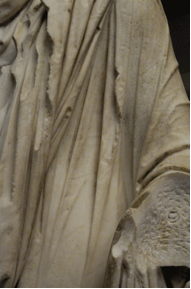 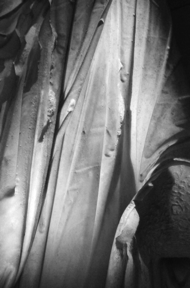 |
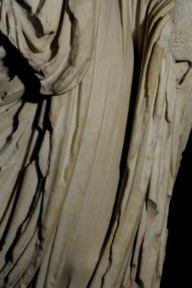  |
| Figs. 24-27 Details of incised press folds and wrinkle patterns on the toga along the left flank of the statue. Photographs: M. Abbe. |
The pristine surface polish on the flesh areas was undoubtedly linked to the subtle and possibly semi-translucent coloration of the skin that gave the impression of a "true" seemingly living, virtual likeness.
Color was an important status signifier in Roman costume, and the coloration of Caligula's costume would have identified immediately the subject as a member within the select Roman patrician elite. Such social membership would have been ascertained by the ancient viewer long before the individual portrait features of physiognomy were read and the specificity of the portrait image was identified. The visual characterization of the Richmond Caligula is thus very much focused on social membership and group identity.[24] The tunic had its purple latus clavus of a Roman magistrate and senator. The toga was colored to designate it as either the (1) purple-boarded toga praetexta, worn by magistrates, or, perhaps more probably, the more highly distinguished (2) all-purple toga purpurea, or, possibly, even the superlatively-distinguished (3) toga picta (all-purple with decorative embroidery). The latter two defined the elite of the Roman elite. Black and red calcei patricii traditionally differentiated the senator from the patrician respectively; Caligula presumably wore the former, more noble color.
This colorful costume and the original life-like painting of the statue created the overall effect of an immediately engaging, active, and living image of the emperor. Today, of course, the absence of such color gives the sculpture an altogether different passive and reserved impression, that is further heightened by the absence (and extensive cutting back) of the figure's arms that originally extended in to the viewer's space.
Caligula stands in a self-composed, statuesque pose of anticipatory, mannered action. His posture is easy and "natural" yet gracefully dynamic. It is defined by a combination of restrained engagement and distance. His head is appropriately raised with an elevated noble air; he turns and acknowledges the viewer--but does not engage directly with him--and retains a properly aloof, aristocratic distance. One senses an immediate, highly personal individual who is effortlessly and harmoniously engaged in his larger, performative public role. Dressed in the national costume of Rome, Caligula is represented as civilis princeps, his most common-attested portrait mode. He is a living manifestation of the proper Roman behavior and values associated with peaceful civic engagement. As an honorific statue, this image undoubtedly embodied the hopes of its patron(s) that the new reign of Caligula would be a long era of civic peace continuing the illustrious precedents of the Julio-Claudian dynasty. The statue conforms to traditional Augustan visual language, but this language is developed to new stylized heights so that the emperor appears in an increasingly elevated, artfully refined, and self-consciously aristocratic manner.
| Statue: monument and intended viewing |
Carved and finished in the round with an exceptionally refined range of subtle surface textures and an acute attention to detail, this sculpture was demonstrably a freestanding honorific statue intended to receive an intimate level of examination and scrutiny from a wide variety of angles.[25] The statue has its own internal narrative as appropriate for a self-sustaining independent figure and could have stood in isolation or as part of a larger Julio-Claudian dynastic group (See the contributions of Liverani and Varner).
The sculpture's archaeological provenience of Bovillae and the fact that it was found with inscriptions recording the Fasti of the Sodales Augustales Claudiales, a very prestigious imperial cult composed exclusively of senatorial elite, make it likely that the statue was dedicated as part of a larger Julio-Claudian dynastic group.[26] Even if the Richmond Caligula was displayed separately from such a larger group, it clearly originated from a context dominated by such dynastic portraits and references.
Though the modern museum visitor sees this and other Roman portrait sculptures as self-contained works of art, the ancient Roman viewer experienced such images as part of a larger monument that consisted of three important elements: (1) the statue (itself composed of two distinct parts: the portrait head and the figured image support or statue-type, here togatus), (2) a tall, often-elaborately molded statue base, and (3) an inscription that was essential in identifying the image and the event or relationship the monument as a whole commemorated. The average height for an early imperial statue-base was approximately 1.0 meter. When combined with the appropriate monumental, slightly over life-size scale of such portraits, one experienced an imposing statue monument of around 2.5-3.5 meters in height.[27]
None of the ancient cuttings for the clamps that secured the ancient plinth of the statue to its now absent base are preserved. Thus, it is not possible to use this often-useful method to determine the precise orientation of the figured image's display on its ancient base. The statue's intended arc of address must be determined internally, namely by the composition and execution of the image itself, which, in this case, is severely hampered by the loss of the arms and the cutting back of that area of the statue in the nineteenth century. While the statue is finished to accommodate a wide range of viewpoints, it displays across its front a clear privileged viewing position when the gaze of the figure is approached straight on.[28] Viewing the statue from this position gives the arresting impression of a self-animated figure turning his gaze to the viewer as he advances towards him. Here, the statue's full width and superlative depth of carving is preferentially displayed. It is from this viewpoint that the slight asymmetries and irregularities in the carving of the portrait image (particularly evident in the shape of the eyes and drillwork of the canthi) disappear and form a remarkably animated visage that "locks" and captures the viewer's attention. Such preferred viewing angles were an essential aspect of the ancient experience of portrait statuary and were related to the larger design of the statue monument. The monument's large, life-like figured image served to capture visually the mobile viewer, often in a specific position, with the hope that he/she would pause and approach the image to read the supporting inscription that identified the individual represented and defined the monument's commemorative function. The positioning and directional focus of the figured image were defined externally according to the specific ancient display context for which it was carved, finished, and colored. The image had to engage experientially the viewer over a range of distances--from afar and to minute inspection--in order to hold the viewer's attention throughout the intended reading process. Such viewer engagement resulted in the distinguished Roman tradition of technically refined, visually engaging, and highly performative portrait statues.[29]
| Ancient statue: life and preservation |
Despite the extensive historic restorations, the exceptional preservation of the ancient core of this over life-size public portrait statue of Caligula is historically remarkable. Several points deserve emphasis. First, the exceptionally well-preserved ancient surface with little ancient weathering indicates that statue was housed in a protected environment, if not indoors, throughout antiquity and never had prolonged exposure to the elements. Its archaeological context must also have been stable enough so as to preserve the statue's ancient marble finishes and surfaces.[30] Second, the absence of any ancient repair, reworking, or refinishing on the sculpture suggests the image had a rather uncomplicated, perhaps brief, ancient statue life. As is increasingly recognized, this was not the case of most ancient marble sculptures, which generally had long, complex ancient histories of multiple use and reuse. This is especially true of public imperial portrait statues. Third and finally, there is no clear evidence for any deliberate defacement or intentional damage to the statue. The existing losses are entirely consistent with the incidental damage evident on numerous other ancient statues (both portrait and ideal) and the surface weathering is akin to those found in the protected environments of collapsed buildings. Though intentional damage may be conjectured, such narratives are in no way necessary to explain the extant condition of the statue. The archival evidence suggests, furthermore, that the statue remained intact in antiquity as it was found with nearly all of its principal parts.
Many of the extant portrait images of Caligula from Rome and central Italy were evidently removed from display around the time of his assassination in 41 CE and were stored and/or subsequently recarved. While the importance of such recarving is increasingly recognized, there is a remarkable series of well-preserved portrait images of Caligula that were either found or acquired in Rome and its environs. Their condition suggests they were simply stored and subsequently rediscovered at a later period in antiquity.[31] Our archaeological understanding for the off-display storage of imperial portraits remains limited, but separately worked portrait heads and busts dominate the existing picture. The Richmond Caligula may be the rare example of the storage of an over life-size image of what was evidently more common practice for smaller pieces.[32]
There is, of course, no conclusive evidence that the Richmond Caligula was taken off view or removed to some manner of storage. Other scenarios are possible. After all, there was no formal or official damnatio memoriae of Caligula's image, and statues of the emperor are known to have remained standing throughout the empire (See the contribution of E. Varner). Moreover, Bovillae was an important center of the Julio-Claudian cult and, thus, a highly unusual environment where "normal" practice need not have applied. The remarkable preservation of the Richmond Caligula can, therefore, be accounted for in various ways: the portrait may have stood throughout antiquity and was found in either its original or a later secondary protected display context. Even if taken off view, it need not be assumed that it had been removed after the dramatic events of 41 CE. The statue may just as easily have been removed much later when its short-reigning emperor was of minor historical importance and no political relevance.
This study of Richmond Caligula has attempted to make this important, and heretofore only summarily described, sculpture more legible in two principal ways: (1) as the core element of a historically defined statue monument erected during the emperor's short reign at Bovillae, the prestigious center of the imperial cult of the Julio-Claudian family near Rome, and (2) as a superlatively crafted artwork with a complex physical history, which emerged from burial in 1825, was restored extensively by R. Tuccimei in 1843, and was largely stripped of these restorations around 1968.
This archaeological description has tried to communicate something of the richly textured characterization and subtlety nuanced meaning that frequently defined such full-length Roman portrait statues in antiquity. Modern scholarship on such Roman portrait sculptures has often tended to reserve such detailed scrutiny to their portrait heads alone. When head and body are studied as a unified ancient whole and are seen properly as part of a highly deliberate and historically defined statue monument, important aspects of their ancient artisanship, display, and intended reception emerge. We should not forget that these artistically refined and once visually arresting life-like honorific statues gave concrete form and a powerful, affective realness to some of the most salient and deeply self-defining ideas of their contemporary Roman audience.
Prof. Mark Abbe
University of Georgia
PUBLICATION HISTORY
(1) Matz, F. and von Duhn, F. 1882. Antike Bildwerke in Rom, mit Ausschluß der größeren Sammlungen. Leipzig: Breitkopf und Härtel. 308, 361-362, cat. no. 1247.
(2) Jucker, H. 1973. "Caligula." Arts in Virginia 13: 16-25, figs. 1-8.
(3) Virginia Museum of Fine Arts. 1973. Ancient Art in the Virginia Museum. Richmond: Virginia Museum of Fine Arts. 122-123, cat. no. 139.
(4) Ternbach, J. 1974. "Further Comments on Caligula" Arts in Virginia 14: 29-31, figs. 1-4.
(5) Jentoft-Nilsen, M. 1980. Ancient Portraiture: The Sculptor's Art in Coins and Marble. Richmond: Virginia Museum of Fine Arts. 58, cat. no. and fig. 59.
(6) Johansen, F. 1981. "Portraetter af C. Iulius Caesar Germanicus kaldet Caligula." MeddelelsGlyptkøb 37: 92, figs. 12, 12a-b.
(7) Jucker, H. 1981. "Iulisch-Claudische Kaiser-und Prinzen-Porträts als Palimpseste." JdI 96: 255 n. 61, 262 n. 77.
(8) Vermeule, C. C. 1981. Greek and Roman Sculpture in America. Berkeley: University of California. 292-293, cat. no. 249, pl. 22.6.
(9) Hertel, D. 1982. "Caligula-Bildnisse vom Typus Fasanerie in Spanien. Ein archäologischer Beitrag zur Geschichte des Kaisers Caius." MM 23: 268, cat. no. 3.
(10) Johansen, F. 1982. "Antike Porträts von Caligula in der Ny Carlsberg Glyptotek." In Römisches Porträt. Wege zur Erforschung eines gesellschaftlichen Phänomens: wissenschaftliche Konferenz 12.-15. Mai 1981. (WissZBerl 31) Berlin: Humbolt-Universität. 223 ns. 6, 10.
(11) Massner. A.-K. 1982. Bildnisangleichung. Untersuchungen zur Entstehungs- und Wirkungsgeschichte der Augustusporträts (43 v. Chr. – 68 n. Chr.). (Das römische Herrscherbild 4) Berlin: Gebrüder Mann. 124 n. 688, pl. 32c.
(12) Johansen, F. 1987. "The Sculpted Portraits of Caligula." Ancient Portraits in the J. Paul Getty Museum. Malibu: J. Paul Getty Museum. 96 n. 26, figs. 16 a-c.
(13) Goette, H. R. 1988. "Mulleus – Embas – Calceus: Ikonografische Studien zu römischem Schuhwerk." JdI 103: 453 n. 233.
(14) Boschung, D. 1989. Die Bildnisse des Caligula. (Das römische Herrscherbild 1.4) Berlin: Gebrüder Mann. 29 n. 12, 38, 53-55, 61, 89, 109-110, cat. no. 11, sketch 11, pls. 11.1-4, 42, 43.1-4.
(15) Goette, H. R. 1990. Studien zu römischen Togadarstellungen. Mainz: Philipp von Zabern. 32, 119, cat. no. B 106.
(16) Picozzi, M. G. 1990. "I marmi della Galleria: l'arredo scultoreo dall'inizio del XVIII secolo." In Catalogo della Galleria Colonna in Roma. Sculture., edited by F. Carinci, H. Keutner, L. Musso, and M. G. Picozzi. Busto Arsizio: Bramante. 56 n. 242.
(17) Ramage, N. H. and Ramage, A. 1991. Roman Art: Romulus to Constantine. Englewood Cliffs, New Jersey: Prentice Hall. 110, fig. 4.8.
(18) Kreikenbom, D. 1992. Griechische und römische Kolossalportäts bis zum späten ersten Jahrhundert nach Christus. Berlin: Waler de Gruyter. 81 n. 638.
(19) Mayo, M. 1998. Ancient Art. Virginia Museum of Fines Arts. Richmond: Virginia Museum of Fine Arts. 78-79.
(20) Romeo, I. and Portale, E. C. 1998. Le sculture. (Gortina III). Rome: "L'Erma" di Bretschneider. 333 n. 335.
(21) Meyer, H. 2000. Prunkkameen und Staatsdenkmäler römischer Kaiser: neue Perspektiven zur Kunst der frühen Prinzipatszeit. Munich: Biering & Brinkmann. 98, figs. 199-200.
(22) Boschung, D. 2004. "Römische Kaiserporträts. Zeichen der Loyalität und Spuren der Revolte." In Kosmos der Zeichen. Schriftbild und Bildformel in Antike und Mittelalter, edited by D. Boschung and H. Hellenkemper. Wiesbaden: Reichert. 262-263, figs. 2, 4.
(23) Varner, E. R. 2004. Mutilation and Transformation, Damnatio Memoriae and Roman Imperial Portraiture. Leiden: Brill. 35-36 ns.112-115.
(24) Hoff, R. von den. 2009. "Caligula. Zur visuellen Repräsentation eines römischen Kaisers." AA 2009.1: 245, fig. 5.
(25) Maderna, C. 2010. "Die Bildhauerkunst während der Regierungszeit des Caligula (37 – 41 n. Chr.)." In Die Geschichte der antiken Bildhauerkunst. IV. Plastik der römischen Kaiserzeit bid zum Tode Kaiser Hadrians, edited by P. C. Bol. Mainz: Philipp von Zabern. 67, 308, fig. 99.
Footnotes
[1]I wish to thank Bernie Frischer, and Peter Schertz and Kathy Gillis of the Virginia Museum of Fine Arts, for facilitating my study of the sculpture and making available to me the museum's files on the statue. I am also deeply grateful to Inge Ternbach Sonn for discussing her father's restoration practices and sharing his archival file on the restoration of the statue, and to Lawrence Becker for sharing his recollections on the 1988-9 examination and conservation treatment. Finally, allow me to thank Julia Lenaghan and the participants in this symposium for their insightful comments on an earlier draft of this paper.
[2] The statue was studied in September 2010 using various
lighting conditions (raking, ultraviolet, infrared photo-induced luminescence), microscopic examination
(using a portable binocular microscope, 5-65X), and preliminary in situ materials characterization
using a portable X-ray fluorescence spectrometer. The results of these technical studies are incorporated in
the archaeological description that follows.
[3]Jucker (1973) 5 "fine-grained"; Boschung (1989) 109
curiously describes it as "grosskristalliner". The medium to small grain-size and the translucency of the
marble are best evident on the roughly worked areas of the historic restoration that are devoid of the
burial staining and significant weathering.
[4]Jucker (1973) 5 identifies the marble as "probably from Cararra despite its relatively pronounced transparency", an identification frequently repeated since. This extremely large block of uniform, flawless, high-quality marble may just as easily be from a Greek/Asia Minor quarry source. Stable isotopic analysis and geological cross-sections of the marble from the upper and lower join surfaces of the head should be undertaken to elucidate the marble type and to aid in finally resolving doubts about whether the head belongs to the body. The symbolic and physical significance of different ancient marbles was a subject of considerable importance in the early imperial period. This important aspect of Roman sculpture production often remains overlooked in the modern study of such statuary. An important and richly evocative exception to this general trend is: Pollini, J. 2000. "The Marble Type of the Statue of Augustus from Prima Porta: Facts and Fallacies, Lithic Power and Ideology, and Color Symbolism in Roman Art." In Paria Lithos: Parian Quarries, Marble and Workshops of Sculpture, edited by D. U. Schilardi and D. Katsonopoulou. Athens: D. U. Schilardi. 237-252. ADDED: As part of an ongoing conservation campaign initiated in August 2012, VMFA plans to subject samples of the marble to scientific analysis.
[5]Jucker (1973) 17. Repeated thereafter, including Boschung (1989) 109.
[6]Bovillae provenance: Picozzi (1990) 56, n. 242. For additional information on the statue's archaeological origins and post-excavation collection history, see Maria Grazia Picozzi's and Paolo Liverani's contributions, this volume.
[7]Matz-Duhn (1882) 308 identifies the display location as "Erdgeschoss: (unten links, die Fenster nach dem inneren Garten zu". Collection history: see the symposium contribution of M. G. Picozzi.
[8]This was, after all, the era of the de-restoration of classical marbles, most notably of the Aegina pediments in the Munich Glyptothek and various marbles in the Ny Carlsberg Glyptotek.
[9]Analysis undertaken by J. Margolis (methodology unrecorded) on C13 and O18 values. No quarry provenance for the marble was proposed.
[10]L. Becker, personal communication, September, 2010. The radiography was discussed in "Futuristic Images of the Past." Du Pont Magazine 1989. 83.5: 18-21. VMFA's conservation department has initiated a new attempt to remove in summer 2012, an ongoing project as of the preparation of this paper.
[11]In isolation the 4 numeral could plausibly be read as a 6. The rightward descender stem of the 4 numeral might be read as a cursorily-carved rightward ascender from the bowl of a 6 numeral. The numeral is clearly not a 6-4 ligature.
[12]Compare, for example, the togatus with an alien ancient head, identified by the restorer V. Pacetti as "l'Imperatore Claudio" c. 1781. Picozzi (1990) 247-250, cat. no. 134.
[13]Similar restored plinths with cut back corners in the Colonna collection: Picozzi (1990) 121-123, cat. no. 66; 171-173, cat. no. 93.
[14]It is noteworthy that the otherwise well preserved statue has a strongly weathered surface locally across the front of the lower legs and plinth. This appears to be the product of post-burial exposure, particularly backsplash, and may be attributed tentatively to weathering/rain exposure in the statue's historic display environment. The upper bodies of such semi-exposed statues frequently receive little such weathering while the lower portions of the statues are more exposed to the elements. Note the display location recorded by von Duhn, supra n. 5.
[15]Archival evidence, scale, workmanship, finish, condition, and preliminary 1989 isotopic analysis all strongly indicate that the head belongs. The long-standing doubts, however, will inevitably remain until there is detailed documentation of the interior join surfaces and proper scientific analysis is undertaken from the two pieces of marble. The scientific analysis should involve two complementary methods: (1) stable isotope characterization and (2) geological cross-sections of the marble from the reworked break surfaces to determine the grain-size of the two pieces of marble and their distinctive trace elements.
[16]Based on examination of the exposed areas and the photographs published in Ternbach (1974).
[17]The proper position of the head can only be securely resolved by the reversal of the existing restoration and detailed examination. (Computer modeling offers an excellent new method of doing this with a previously unavailable degree of precision.) One has the impression that the correct position of the head varies on axes ~0.5 to 1.5 cm from the current restoration.
[18]A nitric- and/or hydrochloric-based acid appears likely. This chemical cleaning appears remarkably even throughout the surfaces and is not concentrated on highpoints. Perhaps it is the result of submersion in a dilute acidic solution.
[19]Note the display location recorded by von Duhn, supra n. 5. The upper bodies of semi-exposed statues in such environments frequently receive little such weathering while the lower portions of the statues are more exposed to the elements.
[20]Joining the forearms prevented the marble block from being unnecessarily wastefully deep and eliminated the need for obscuring marble struts across the front of the statue.
[21]There is no evidence for the quarry face of the original block on the top of the head as one often finds on such statues where the height of the block was maximized. The underside of the ancient plinth is encased within the larger modern plinth.
[22]Though such integrity was undoubtedly invisible in the final display, it could demonstrate to the client during the production process that the commissioned statue was an entirely newly-carved work, not a recycled piece of secondary use. Having the head materially integrated may have made such an image less immediately prone for reuse and thus a seemingly more permanent dedication that would more likely last the ages, like the marble material itself.
[23]Small amounts of calcite and carbon black are evident, principally on the external surfaces of the samples; neither can be confidently associated with the ancient coloration and they tentatively can be attributed to redeposited calcium carbonate from the stone substrate and carbon black from burial, weathering, and museum environment exposure, respectively. No lead white was detected. Raman analysis was undertaken at the Department of Scientific Research, Metropolitan Museum of Art by Marco Leona and Federica Pozzi.
[24]Individual physiognomy was, in contrast, privileged in the more intimate statue format portrait busts. See also Østergaard, J. S. 2007. "Verae imagines? Portraits of the Family of Agrippina Minor in the Ny Carlsberg Glyptotek." In Agrippina Minor. Life and Afterlife, edited by M. Moltesen and A. M. Nielsen. Copenhagen: Ny Carlsberg Glyptotek. 73-76.
[25]It is far removed from the summary definition and finish, and the flatter, more iconic rendering typical of images intended for elevated architectural display.
[26]On Bovillae and the statue's plausible display context, see the contribution of P. Liverani.
[27]Højte, J. M. 2005. Roman Imperial Statue Bases. Aarhus: Aarhus University Press. Statue bases for Julio-Claudian imperial portraits predictably vary in height (0.80-1.40 m), but are generally at least 1.0 m in height. The ancient plinth of the Richmond Caligula was presumably significantly shorter than that of the historic restoration; perhaps at most half its current height.
[28]This view is well captured in the large image in Jucker's 1973 article fig. 1, reproduced in Boschung 1989, full-size pl. 42.
[29]In post-antique historic collections, in contrast, ancient sculpture was typically displayed in a less direct and arresting manner as appropriate for its principal role as decorative domestic "art". The intended later viewing of the Caligula is clearly defined by its rectangular modern plinth. The statue is compositionally centered around its prominently advanced static left leg forward that is privileged and oriented perpendicularly to the front of the plinth. This positioning creates a more static, reserved, and formal image with a strong frontal view. The figure, turning away from the viewer, exists in a removed, higher realm of aesthetic pure form and distant history.
[30]Anecdotally, this is akin to ancient sculptures found within the sealed debris of collapsed buildings in the author's limited experience. The preserved surfaces and damage to the statue are strikingly consistent with such a burial context.
[31]The archaeology for these pieces is practically non-existent, but the majority came to light in the late nineteenth and early twentieth centuries, the era of Rome's massive urban expansion and the suburban development of the Campagna. The majority may have originated from suburban luxury villa contexts.
[32]Storage: Varner (2004): 30-35; Højte (2005) 56-63; Fejfer, J. 2008. Roman Portraits in Context. Berlin: Walter de Gruyter. 390-393. A recent and relevant well-contextualized find: Weiss, R.-M., Schäfer, T., Osanna, M., eds. 2004. Caesar is in der Stadt. Die neu entdeckten Marmorbildnisse aus Pantelleria. Hamburg: Helms-Museum. Statues: Varner (2004) 30-35; bases: Højte (2005) 56-63.
Back to Papers
Copyright © 2009-13. Last updated: March 22, 2013.
The Digital Sculpture Project is an activity of the Virtual World Heritage Laboratory.
